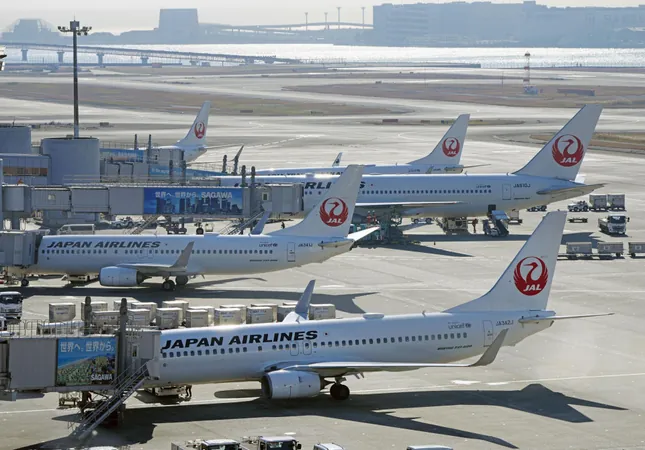
A Survivor's Tale: The Unforgettable Horror of the 2004 Andaman Tsunami
2024-12-26
Author: Noah
A Survivor's Tale: The Unforgettable Horror of the 2004 Andaman Tsunami
Boxing Day, December 26, 2004, will forever be etched in the memories of those who experienced the catastrophic tsunami that struck the Andaman and Nicobar Islands. As I boarded a ferry bound for Havelock Island, I had no idea that within minutes, my life would change forever.
The ferry was bustling with excitement as families, including my best friend's, boarded for a day of leisure on one of Asia's most beautiful beaches, Radhanagar, recognized for its stunning silver sands and sparkling waters. However, as we departed from the Phoenix Bay jetty in Port Blair, the ground beneath us began to tremble.
Suddenly, the unimaginable happened: the jetty crumbled, followed by the nearby watchtower and electricity poles collapsing into the ocean. I stood frozen in disbelief along with fellow passengers—witnesses to this extraordinary and terrifying sight. Thankfully, no one was at the jetty at that moment; a boat scheduled to depart later had not yet arrived.
Our crew informed us that we were experiencing an earthquake, although I had no idea of its magnitude or its deadly potential. The quake, measuring 9.1 on the Richter scale, would soon unleash a catastrophic tsunami that would devastate nations across the Indian Ocean, claiming up to 228,000 lives across a dozen countries—including Indonesia, Sri Lanka, and India.
Just 100km from the quake's epicenter, the islands faced the full wrath of the tsunami. Within a mere 15 minutes, towering waves reached heights of 15 meters, sweeping across coastal landscapes and wreaking havoc. The official death count in the Andaman and Nicobar Islands was reported at 1,310, but with thousands unaccounted for, the true toll was likely far higher.
As our boat drifted in the turbulent waters, communication with the outside world was lost. We could only glean snippets of information about destruction in nearby lands, while the devastation unfolding in our immediate vicinity remained shrouded in uncertainty. An estimated 94% of the islands' jetties sustained serious damage, leaving communities isolated.
Ultimately, we never reached Havelock. The jetty there was submerged, forcing our vessel to pivot back to Port Blair, where we encountered an alarming scene of devastation. Buildings lay in ruins, boats littered the streets, and families were left without homes as floodwaters engulfed their neighborhoods.
One of the most heart-wrenching moments was meeting a young girl—a mere nine years old—who had narrowly escaped drowning in her own home. I listened to countless stories of loss, like that of a woman who lost every possession she owned in seconds.
In the immediate aftermath, I dedicated weeks to covering the calamity and its far-reaching impacts. This was the first tsunami to devastate the Andaman and Nicobar Islands, and the scale of destruction was unprecedented. Saltwater contaminated freshwater sources, and agriculture was decimated, complicating relief efforts significantly.
In those chaotic days, the Indian military mobilized for a massive rescue and relief operation. In Port Blair, makeshift shelters were established in schools and government buildings, providing refuge for thousands of displaced families. Survivors shared harrowing accounts—like one woman from Car Nicobar who described both the initial earthquake and the tsunami's arrival as eerily synchronized, with water spewing from the ground as the wave rushed in.
As the days passed, tremors of aftershocks became common, reigniting fears of additional tsunamis and sending residents scrambling for higher ground. An official tour led us to Car Nicobar, where destruction was thorough, and at least a hundred lives were lost, including many from the Indian Air Force stationed there.
Witnessing the extent of the tragedy—families torn apart, homes reduced to rubble, and personal belongings strewn across once-thriving neighborhoods—was sobering. Amidst the wreckage stood a solitary bust of Mahatma Gandhi, surviving in stark contrast to the chaos surrounding it.
My memories of that fateful day remain vivid. Each December 26 serves as a reminder of the fragility of life and the minuscule margin that separates safety from catastrophe. I often wonder what might have transpired had the earthquake struck just minutes earlier or later.
Though I was fortunate to escape the tsunami that day, an overwhelming number were not. Their stories deserve to be heard and remembered, as a solemn tribute to lives lost and a testament to resilience in the face of unspeakable tragedy.
This harrowing experience calls for renewed awareness and preparedness, ensuring that we never forget the lessons learned from that catastrophic day.









 Brasil (PT)
Brasil (PT)
 Canada (EN)
Canada (EN)
 Chile (ES)
Chile (ES)
 España (ES)
España (ES)
 France (FR)
France (FR)
 Hong Kong (EN)
Hong Kong (EN)
 Italia (IT)
Italia (IT)
 日本 (JA)
日本 (JA)
 Magyarország (HU)
Magyarország (HU)
 Norge (NO)
Norge (NO)
 Polska (PL)
Polska (PL)
 Schweiz (DE)
Schweiz (DE)
 Singapore (EN)
Singapore (EN)
 Sverige (SV)
Sverige (SV)
 Suomi (FI)
Suomi (FI)
 Türkiye (TR)
Türkiye (TR)